Let's stay in touch! Subscribe to our newsletter below or follow us on social media.
Copyright © 2020 VitaSim. All rights reserved.

Since 2018, VitaSim has been researching and developing solutions using virtual reality (VR) to facilitate training and learning. During this time, we have helped universities and hospitals in Denmark and abroad conducting research to understand the effect on learning outcomes of using VitaSim’s VR solutions for training and educational purposes.
Hands-on training and apprenticeships are important for training procedures in several professions. However, it can be difficult to achieve ideal learning conditions, either because an instructor is not always available or there are parts of a procedure that are difficult to simulate in the classroom (e.g., use of expensive equipment or procedures that involve safety risks). VR simulation training can overcome these problems by allowing learners to make mistakes and learn from them in a safe virtual training environment.
The VitaSim VR platform enables educators to teach through a “virtual apprenticeship” method that we have dubbed “VR Mirror Learning”. With this method professional instructors record their virtual avatar as they explain and perform a given procedure. This allows students to always have an expert at hand – at least virtually. By watching the virtual instructor perform procedures and listening to their explanations while practicing the procedures themselves, students can receive thorough, guided one-to-one training.
It is critical for us that the VR solutions we develop are supported by research, and that we can provide scientific documentation that these solutions help our users learn.
We are convinced that, when applied at right points in a learning process, technology can enhance learning, and we have participated in several studies that support this. On the following pages you can read summaries of these studies with links to complete articles if you wish to read more.
Enjoy!

Diving into the digital realm of education, a new research project recently assessed how Virtual Reality (VR), particularly VitaSim’s VR simulator, can transform radiography education.
The objective behind this research was straightforward yet profound: Can a VR simulator genuinely assist radiography students in mastering the skill of taking X-rays, especially of the wrist? To elucidate this, the study was designed to involve 10 students, offering them a chance to experience VitaSim’s VR simulator firsthand.
Confidence Measure: Students were evaluated on their confidence level in taking wrist X-rays both pre and post their simulator experience. While one might expect a surge in confidence post-simulation, the results showed no significant increase.
Perception of Realism: The simulator’s success wasn’t solely about boosting confidence. An overwhelming 90% of the participants found the VR X-ray room to be strikingly realistic.
Educational Value: Beyond realism, a majority felt that the VR simulator could be a significant asset to their educational journey.
Future Potential: While the immediate confidence boost was not noted, the researchers were unanimous about one thing: VR holds incredible potential as a pivotal learning tool in radiography. However, they also emphasize the need for more comprehensive research in this domain.
The bedrock of this research was the dedicated team behind it. Heartfelt gratitude goes to Janni Jensen, the torchbearer of this study. Additionally, commendations are due to the contributing researchers: Ole Graumann, Rune Overgaard Jensen, Signe Gade, Maria Grabau Thielsen, Winnie Most, and Pia Iben Pietersen.
It’s crucial to understand that while VitaSim provided the VR simulator software, the company’s role was solely that of a software provider, ensuring no bias in the research.
VitaSim, with the feedback from this study in hand, is fervently working towards refining and expanding its VR simulator offerings. As we usher in the new year, a promising revelation stands out: half of Denmark’s radiography schools are set to integrate VitaSim’s simulator into their curriculum. Furthermore, efforts are underway to promote its use across Europe. A particularly thrilling announcement for all is VitaSim’s ambition to expand the simulator’s reach to cover all major joints.
In essence, while VR’s immediate impact on confidence may still be a topic of debate, its potential as a transformative tool in radiography education is undeniable. The journey is just beginning, and the horizon looks promising.
Read the entire study HERE


Purpose and Background:
With a staggering annual number of up to 20 million wrist fractures globally, the call for adept surgeons has reached an unprecedented high. To meet this demand, the absence of commercially available simulators specifically tailored for open wrist fracture surgery training became apparent. In a pioneering response, VitaSim, alongside experts from the renowned CAMES simulation center, embarked on the development of the groundbreaking Virtual Reality Basic Osteosynthesis Surgery Simulator or VR-BOSS. This simulator intends to bridge the existing gap in simulation-based training, offering an evidence-driven tool for surgeons-in-training.
Study Design and Methodology:
VR-BOSS is not a mere leap in technology but an evolution in the approach to surgical training. It’s grounded on a recently formulated assessment tool, devised through international expert consensus, and now published in The Journal of Hand Surgery. This project represents a synergistic collaboration between CAMES and the globally recognized orthopedic body, AO Foundation. The simulator is structured to allow prospective surgeons to learn and adapt from errors, enabling repeated practice till proficiency is achieved—ensuring that when they do commence actual surgeries, they do so under guided supervision, thus amplifying patient safety. Designed predominantly for nascent orthopedic surgeons, VR-BOSS also offers a dynamic learning avenue for operating room nurses and stands as a valuable refresher or ‘re-certification’ module for veteran surgeons. The primary hardware requirements for this revolution encompass a competent computer and VR goggles.
Main Academic Takeaways:
Results:
Findings:
The inception and realization of the VR-BOSS is credited to a collaborative endeavor between VitaSim and experts from the distinguished simulation center, CAMES. Additionally, this pioneering venture was supported and co-developed in association with the renowned orthopedic entity, the AO Foundation.
It is essential to emphasize that VitaSim’s involvement was strictly as a software provider for the simulator, ensuring its efficient and effective functioning.
This endeavor showcases the power of collaboration, uniting expertise from various domains to pave the way for a transformative leap in surgical training and, by extension, healthcare outcomes.


Focused lung ultrasound (FLUS) examinations are used to diagnose the causes of acute shortness of breath. To diagnose patients correctly and initiate prompt and correct treatment, doctors must have the right skills. However, it can be difficult to practice FLUS, because testing on patients with acute respiratory problems can delay their actual diagnosis and treatment.
The aim of this randomized controlled study was to 1) learn whether doctors and medical students could use VR equipment to practice at home and learn how to perform FLUS, and 2) investigate the learning outcomes of implementing gamification in VR training.
The researchers recruited 48 doctors and medical students. 24 participants were randomly selected to practice at home with a gamified VR training scenario, and 24 participants practiced at home with a non-gamified VR training scenario. Afterwards, the participants were asked to perform FLUS on a physical simulator and their performance was evaluated by a blinded assessor.
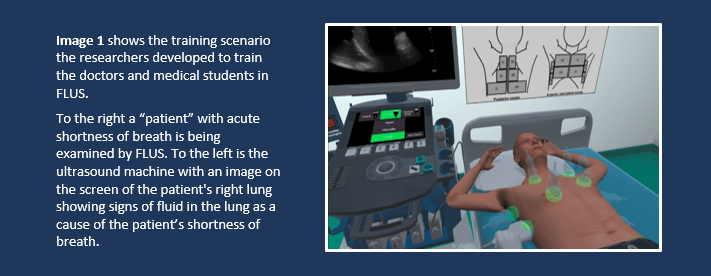
The participants had the VR headset at home for an average of 4 days and spent 3–3.5 hours practicing FLUS at home.
The study showed that participants who received VR training in FLUS scored statistically comparable to participants who had received the training via traditional courses and who used lung ultrasound examinations in their daily clinical work with patients.
The study found no difference in test scores between participants who received VR training with gamification (15.5 points) and those without gamification (15.2 points). Thus, the use of game-based elements in VR training had no significant effect on the learning outcome.
The study showed that VR training could be used as an unsupervised course for untrained individuals who could even practice at home, outside the hospital.
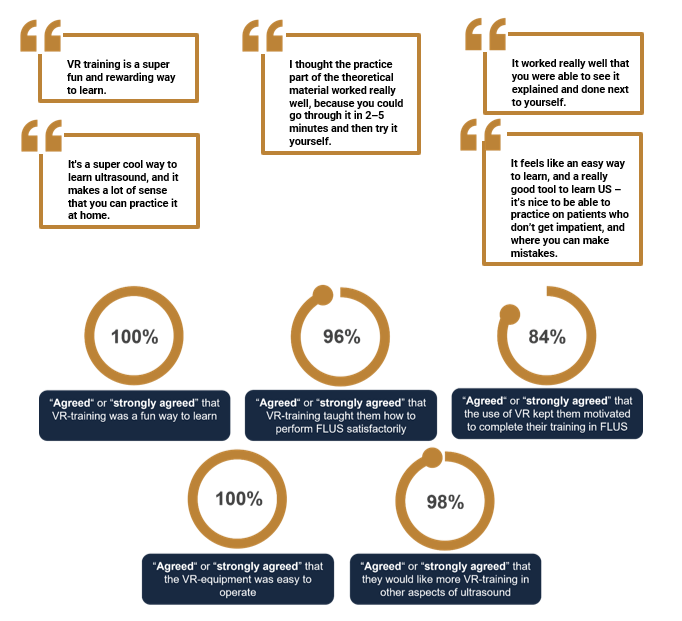
Link to the full study:
https://www.umbjournal.org/article/S0301-5629(22)00640-8/fulltext


The content and methods involved in training medical students in focused ultrasound examinations can vary greatly. VR training in focused ultrasound could potentially be performed without the presence of medical instructors or the use of expensive ultrasound equipment that is required for face-to-face education.
The aim of this randomized controlled study was to develop a self-directed training course in VR and to compare the learning outcomes of VR training with traditional face-to-face ultrasound training.
The researchers recruited 104 medical students from the University of Southern Denmark. 53 students were randomly selected to receive only face-to-face training, and 51 received only VR training. Afterwards, the students were asked to perform a basic ultrasound examination on a phantom and were evaluated and scored by a blinded assessor.
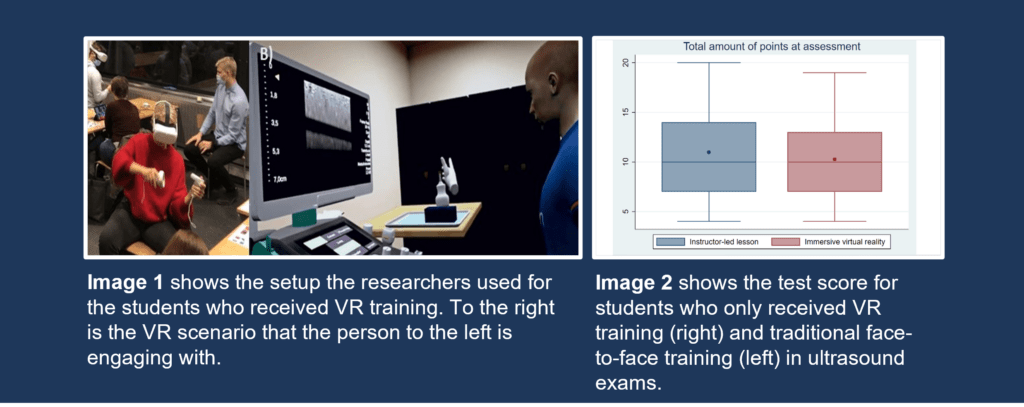
The study showed that medical students who received VR training scored as well as the students who received traditional face-to-face training in focused ultrasound examinations (see image 2). Starting costs for the implementation of the courses proved to be 16 times higher for traditional training compared to VR training.
The study showed that the learning outcome from a VR course was not different from the learning outcome from a traditional face-to-face course in ultrasound examinations. The results indicate that a VR course can be an alternative and equal substitute for face-to-face lessons.
Link to the full study:
https://pubmed.ncbi.nlm.nih.gov/36216656/


Contrast-enhanced ultrasound is among other things used to light up tumors in ultrasound images and make it easier to localize and perform biopsies. It is an invasive examination that can cause discomfort to patients and is difficult to train in the real world, as it involves the use of expensive equipment, voluntary patients, and an injection of contrast media into the blood stream.
This study was not about VR-based training, but rather investigated whether VR could be used as a competence assessment tool. When is a doctor ready to start performing contrast-enhanced ultrasound on patients?
The researchers behind the project developed a VR-based simulation test for contrast-enhanced ultrasound examinations. They included 25 doctors with different levels of experience in this procedure and gathered validity evidence to see if the test could distinguish beginners from experts. They also defined a limit for passing the test.
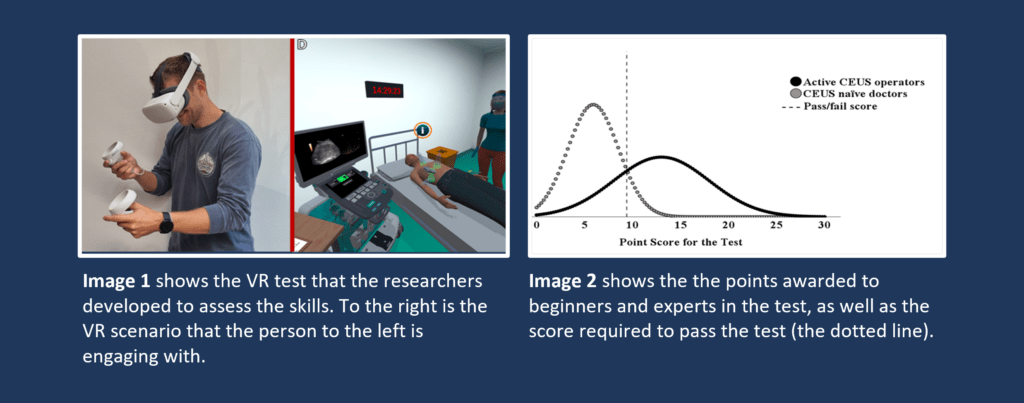
The researchers in the study managed to determine 23 elements in the VR test that could distinguish a beginner from an expert in contrast-enhanced ultrasound examinations. Beginners scored an average of 6 points, while experts scored an average of 13 points, which resulted in establishing a passing grade of 9 points based on statistical analysis.
This study managed to develop a skills assessment tool that can help assess when a professional is ready to perform a risky procedure in a real environment.
Link to the full study:
https://pubmed.ncbi.nlm.nih.gov/35227531/


Placement of peripheral venous catheters (PVC) is a procedure used in many areas of the healthcare sector to deliver fluids or medicine directly into a patient’s bloodstream. For an untrained person, it can often be difficult to place a PVC correct – often causing great discomfort to the patient, as it can take several attempts to get it placed correctly.
The aim of this pilot study was to examine the learning effect of adding approximately 15 minutes of VR training to an existing e-learning course on ultrasound-guided placement of PVC.
The researchers behind the project recruited 19 medical students from University of Southern Denmark, where 9 students were randomly selected to receive only e-learning, while 10 students received only VR training. Afterwards the students were asked to place a PVC on a training phantom.
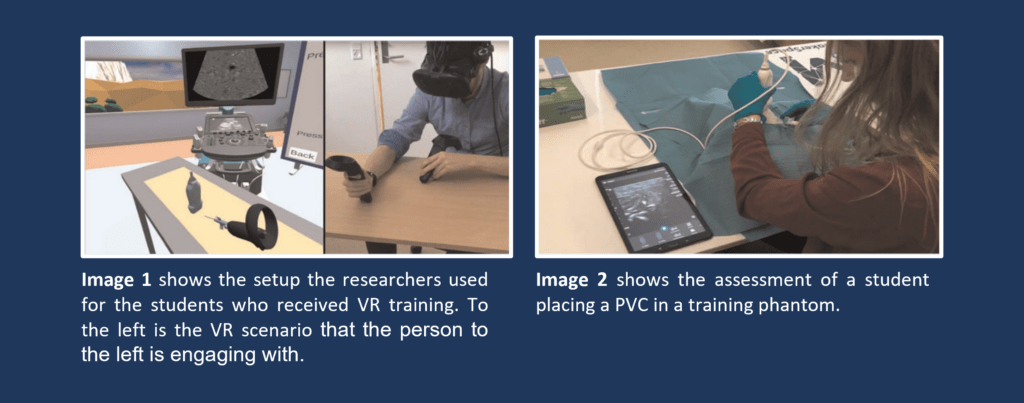
The subsequent test showed that the group receiving VR training placed the PVC correct in 22 out of 30 cases, whereas the group without VR training only placed the PVC correct in 6 out of 27 cases. The study showed a relative improvement of more than 300% in correct placement of a PVC in the group that received the supplemental VR training compared to e-learning alone.
The study showed that adding VR training to an already existing e-learning course could significantly increase the learning outcome.
Link to the full study:
https://www.ncbi.nlm.nih.gov/pmc/articles/PMC8270624/


Medical ultrasound has evolved greatly over the past few years. It is no longer a tool reserved for specialists, but is now also used by doctors in emergency rooms and by medical students. This growing interest makes it imperative for educators to find new ways to instruct their students.
The aim of this randomized controlled pilot study was to compare the learning outcomes of basic ultrasound training via e-learning with that of virtual reality.
The researchers behind the project recruited 20 medical students from University of Southern Denmark. 9 students were randomly selected to receive only e-learning, and 11 students received only VR training. Afterwards, the students were asked to perform a basic ultrasound examination on a person and were evaluated with a test scores given by a blinded assessor.
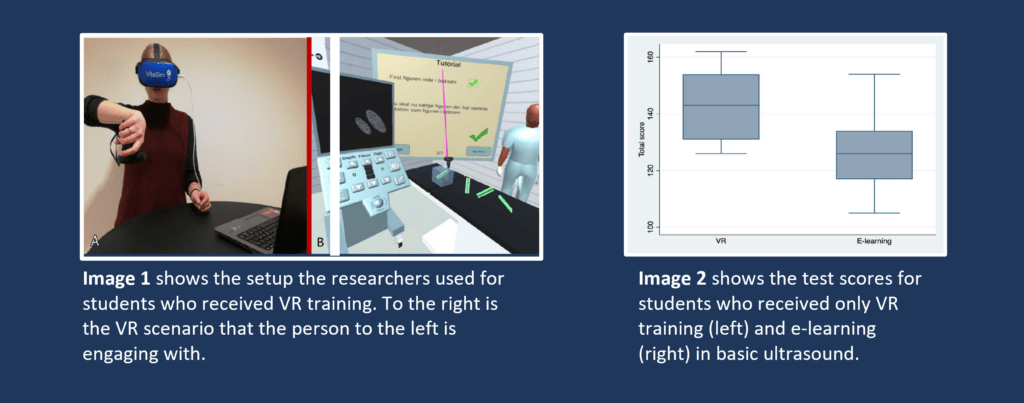
Medical students who received VR training scored on average 143 points in the test, while the group receiving e-learning only scored 126 points (see image 2). In the VR group, 91% of the students wanted more VR training in the future.
The study showed a modest but still statistically significant higher learning outcome by using VR as a training tool compared to e-learning.
Link to the full study:
https://pubmed.ncbi.nlm.nih.gov/34478430/


Title: Virtual Reality – The Future of Ultrasound Training, or Just a Gimmick?
Authors: Research and Innovation Unit of Radiology, OUH
Published in: Ultraschall in der Medizin
Subject: Brief status article on challenges related to education and training in organ-focused ultrasound, as well as how virtual reality training can have an impact on this.
Link: https://www.thieme-connect.de/products/ejournals/html/10.1055/a-1652-8021

Title: Virtual Reality Head-Mounted Displays in Medical Education – A Systematic Review
Authors: Copenhagen Academy for Medical Education and Simulation (CAMES)
Published in: Simulation in Healthcare – Journal of the Society for Simulation in Healthcare
Subject: A systematic review of all research articles related to the use of virtual reality in medical education.
Link: https://pubmed.ncbi.nlm.nih.gov/35136005/

Title: Virtual Reality prepares healthcare professionals for everyday clinical life
Authors: Research and Innovation Unit of Radiology, OUH, Center for Simulation Training (SimC), OUH
Published in: Member’s magazine Medicoteknik
Subject: A longer status article on the use of virtual reality in the healthcare sector in Denmark. Also highlights project and research challenges.
Link: http://ipaper.ipapercms.dk/TechMedia/Medicoteknik/2022/?page=22
